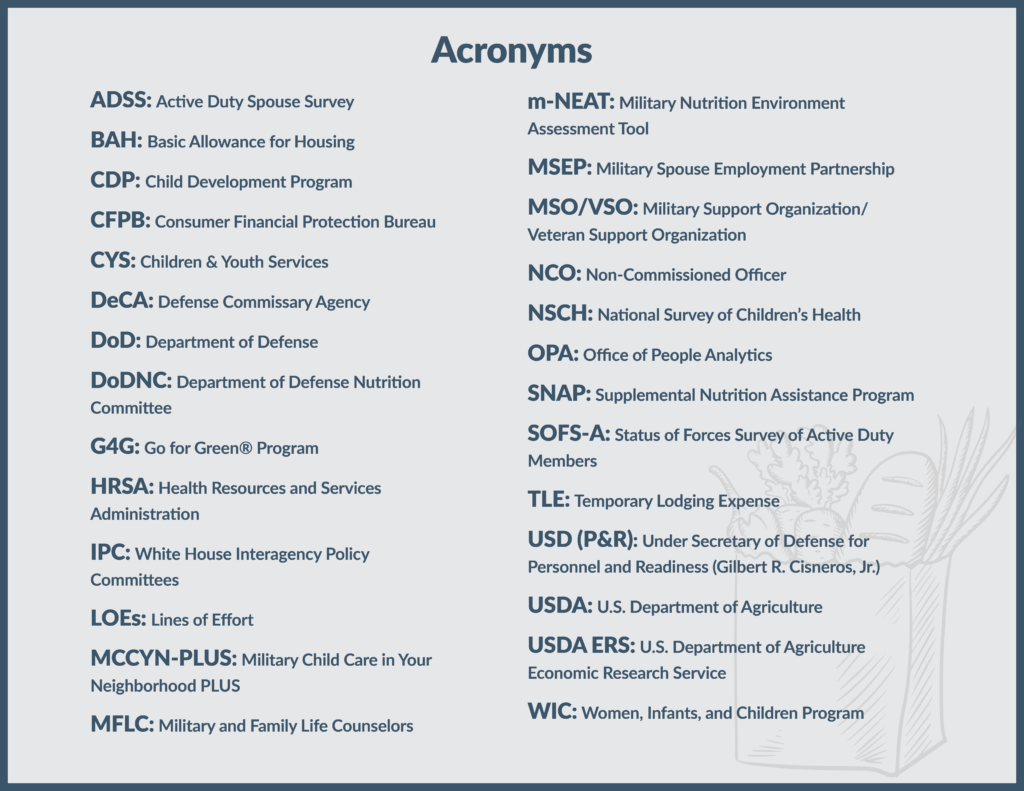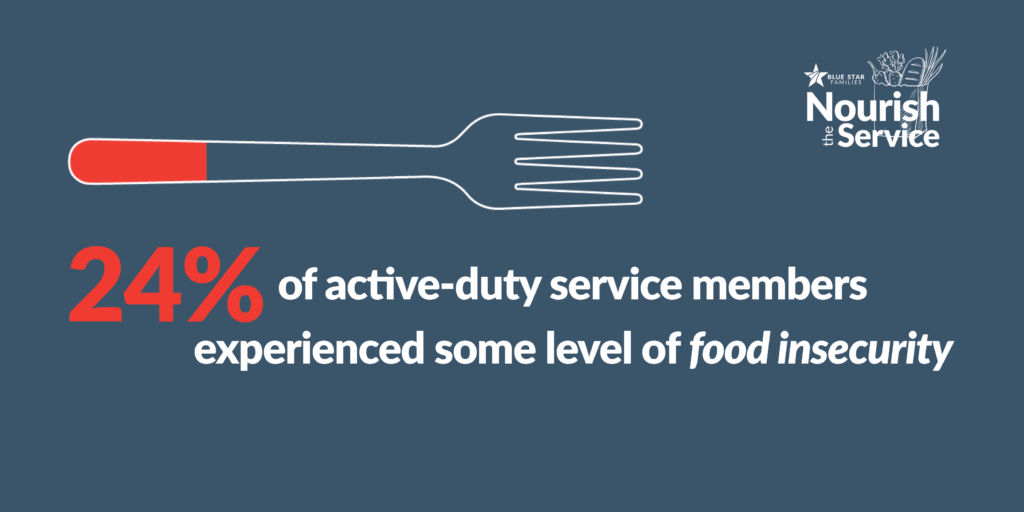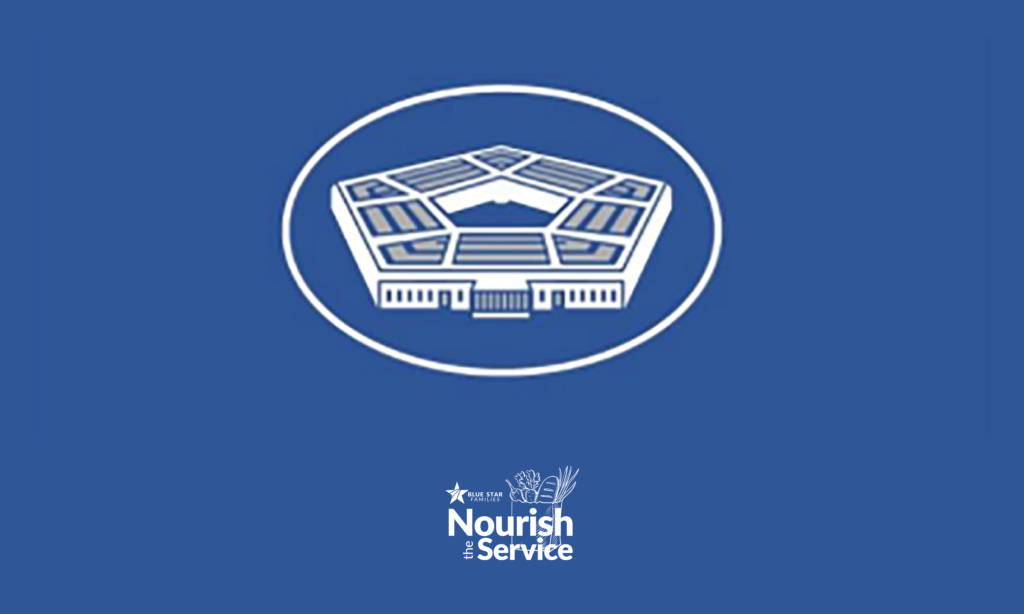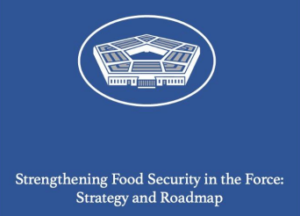Published: July 29, 2022
The TL;DR (Too Long; Didn’t Read) Version
In November 2021, Secretary of Defense Lloyd Austin issued a memo, “Strengthening Economic Security in the Force.” It directed the following actions:
- increase Basic Allowance for Housing (BAH)
- extend Temporary Lodging Expense (TLE) in areas with housing shortages
- field a new Military Leaders Economic Security Toolkit to help leaders identify struggling service members and connect them to resources
Additionally, a strategy and implementation roadmap on strengthening food security in the force was ordered by Secretary Austin, with a due date of 90 days from the date of the memorandum. The Department of Defense released the strategy and roadmap on July 14th, 2022.
Visit the Department of Defense Publications page to download the full report.
Given the busyness of life, reading through a 12-page report may not be something you have time to do. For your convenience, we at Nourish the Service put together a bulleted, TL;DR version of key highlights and takeaways.

Definitions
Food insecurity is defined as inadequate access to food because of a lack of money and other resources. Households can be placed in one of the following categories, and the level of food security is measured by a series of six questions developed by the USDA.
- High food security: no reported indications of food-access problems or limitations
- Marginal food security: one or two reported indications—typically of anxiety over food sufficiency or shortage of food in the house; little or no indication of changes in diets or food intake
- Low food security: reports of reduced quality, variety, or desirability of diet; little or no indication of reduced food intake
- Very low food security: reports of multiple indications of disrupted eating patterns and reduced food intake
Surveys
- SOFS-A: a web-based, active-duty survey fielded from October 26th, 2020, through January 25th, 2021, to a random sample of over 1.3 million active-duty service members across all service branches, in the U.S. and overseas
- ADSS 2021: a web-based, biennial survey that allows active-duty spouses to provide feedback about their military life experience
Statistics
Blue Star Families first surveyed members in 2020 about food insecurity, and 14% of active-duty respondents reported facing food insecurity. At that time, the DoD had not collected data on food insecurity. Now, the numbers are out, and they aren’t good.
Here are some military food insecurity statistics you should know about:
- The 13th Quadrennial Review of Military Compensation, completed in 2020, reported that 0.08-0.1% of service members use SNAP benefits (Note: these numbers are low because the USDA includes BAH as income, which serves as a barrier for most military families to qualify for benefit use)
- 76% of total active-duty service members were food secure
- 24% of active-duty service members experienced some level of food insecurity
- 14% reported experiencing low food security
- 10% reported experiencing very low food security
- 43% of enlisted service members with an unemployed spouse reported experiencing food insecurity
- 41% of unemployed military spouses reported food insecurity, compared to 22% of employed military spouses who reported food insecurity

A Holistic Approach to Solving Food Insecurity
The report highlights ongoing efforts to bolster economic security in the force, and the DoD outlined the following LOEs that seek to strengthen food security through a holistic approach.
- Increase Access to Healthy Food
- Enhance Spouse Economic Opportunities
- Review Service Member Pay and Benefits
- Reinforce Financial Resources and Awareness
- Encourage Service Members and Families to Seek Available Resources and Services
- Expand Data Collection and Reporting
Let’s explore each of these efforts in more detail…
Increase Access to Healthy Food
The Department of Defense Nutritional Committee (DoDNC) is working to enhance healthy eating by measuring access to healthy food options and improving choices for service members. Reason being, accessible and affordable food is a readiness issue.
- DeCA will increase access to on-the-go, ready-to-eat, economical, and healthy dietician-approved food options. It is conducting a 90-day grocery delivery pilot program in eight CONUS (continental U.S.) locations.
- Military departments will review dining facility hours and access to healthy options, especially for service members who work nontraditional hours or who may not have access to dining facilities.
- The DoD will continue to participate in the White House IPC on Nutrition and the Conference on Hunger, Nutrition, and Health to seek solutions.
Enhance Spouse Economic Opportunities
It’s no secret that spouse employment has been an issue for years, and it impacts military families’ economic well-being. Ensuring spouse employment can be an upstream solution that prevents military families from becoming food insecure.
- Military spouses can soon expect better connections with employment opportunities as the DoD partners with MSEP.
- Seven professions–teaching, social work, cosmetology, massage therapy, dentistry/dental hygiene, school psychologists, and dietician nutritionists–will soon have interstate licensure compacts to promote licensure portability.
- The DoD is working with the White House’s Joining Forces Sub-IPC on federal employment to connect military spouses with federal job opportunities.
- The Child Development Program (CDP) will soon have improved recruitment and retention, aiming to offer military spouses more employment options and improve capacity at CDP facilities.
- Expansion of the Military Child Care in Your Neighborhood-PLUS program will increase the pool of local community child care providers that can receive subsidies in the form of fee assistance on behalf of military families.
- The Department of State will allow military spouses employed as federal civilians to work remotely from overseas locations.
Review Service Member Pay and Benefits
Economic insecurity and food insecurity are closely tied. Military spouses who are DoD employees now receive a minimum wage of $15 per hour in accordance with President Biden’s directive issued in January 2022.
- The Basic Needs Allowance (BNA), which will serve as a safety net for eligible service members and families in need, will start January 2023.
- More options may be available soon for increased dislocation allowance that service members receive to defray out-of-pocket PCS (permanent change of station) costs.
- Dependent Care Flexible Spending Accounts for service members is being evaluated.
- BAH is being analyzed.
Reinforce Financial Resources and Awareness
Amplification of financial education and counseling resources helps service members gain awareness and use these services. The DoD’s annual Financial Readiness Training Symposium in the spring of 2022 worked to provide installation personal financial managers with essential updates and skills to support service members and their families.
- Self-guided financial well-being assessment tools designed to help service members assess and identify resources to strengthen their financial well-being will launch soon.
- New recruits and officers can soon expect mandatory financial education programs prior to entering active duty.
Encourage Service Members and Families to Seek Available Resources and Services
The expansion of a web of resources meant to encourage help-seeking behavior and increasing awareness assists service members and their families in finding and using these services with less stigma and fewer barriers. More trained professionals who can assess and discuss food insecurity may serve on the front line to provide service members and families with upstream assistance.
- Military-connected organizations will be invited to roundtables to discuss food insecurity and leverage relationships.
- The Economic Security strategic communications plan, in collaboration with the White House Joining Forces, will increase awareness through targeted social media posts, Facebook live events, and meetings with senior spouse groups and senior leadership.
- DeCA will continue outreach and awareness to educate patrons on the commissary benefit and increase awareness around SNAP and WIC, allowing patrons to shop and pay online.
- Military OneSource’s Military Leaders Economic Security Toolkit will be evaluated for improvements.
- A “Resources at the Ready” campaign will increase service member and family awareness of military benefits and quality of life resources.
Expand Data Collection and Reporting
The DoD will use SOFS-A/ADSS data, along with others, to inform ongoing efforts and continue to seek more data and analysis. It has implemented proactive screening tools to identify potential food insecure children through surveys on electronic health records.
- The DoD will execute qualitative research, including interviews and focus groups, to gain installation-level insights.
- The DoD will engage USDA ERS experts on food security.
- Expect more studies, including one on food deserts and impact. OUSD (P&R) will analyze food insecurity data based on survey findings of household experiences during the coronavirus pandemic, and it will also administer the 2022 Reserve Component Spouse Survey and the Status of Forces Survey of the Reserve Component with the USDA six-question measure of food insecurity.
- The DoD will continue to co-chair the Joint Forces Sub-Interagency Policy Committee to learn more about severity, determinants, consequences, and potential ways to address food insecurity in military and Veteran populations.
- The DoD’s nutrition data will be enhanced by HRSA and NSCH information.
- All Military and Family Life Counselors will screen for food insecurity when they meet with service members and families.
Conclusion
While the statistics look bleak at the moment, the “Strengthening Food Security in the Force: Strategy and Roadmap” is a positive step the Department of Defense is taking to ensure that service members and their families can thrive while serving, therefore improving the readiness and health of our All-Volunteer Force. Perhaps these steps, and the focus on holistic solutions, will ensure our military members and their families experience both improved physical and economic well-being.
Posted In: Food Insecurity


